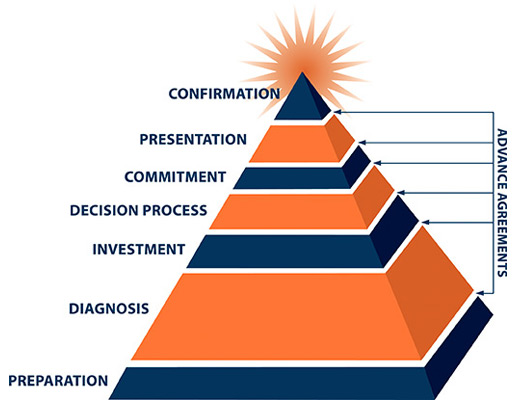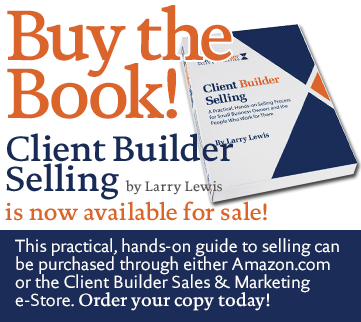Client Builder Selling is a selling system tailor-made for businesses that sell solutions to problems, regardless of whether those solutions come in the form of products, services, or some combination of both. Although it simplifies the sales process and puts control in the seller’s hands, it is equally beneficial to the parties on both sides of a deal. It gives business owners, independent professionals and salespeople a proven, practical, repeatable method for increasing their odds of closing every deal in the shortest possible timeframe at the highest possible margins.

The Seven Steps in the Client Builder Selling Process
At the core of the Client Builder Selling process is a series of seven steps held together by something called Advance Agreements.
- Preparation: The objective of this step is to gather sufficient information about your market and the individual prospects it so that you can begin to qualify your prospects and make the best possible impression on your initial sales call.
- Diagnosis: This step is where you determine whether your prospect has “pain” – a compelling, personal reason to acquire your product or service. The diagnosis can take on several different forms depending on what you sell and how aware your prospects are about needing or wanting what you offer. As the name of this step implies, like a good doctor, your job is to get at the root of what’s causing your prospects pain so that you can prescribe the right solutions when it’s time to present. It’s where the lines of communication are established and the relationship is built. It’s also where the sale is typically won or lost.
- Investment: The goal of this step is to determine whether your prospect is willing and able to invest the resources required to fix the problems or seize the opportunities you uncovered in the diagnosis step.
- Decision Process: Although the questions asked in this step are extraordinarily simple they are often overlooked. As a result, salespeople frequently find themselves presenting to people that do not have the authority to make a final decision on whether to buy. In this step the objective is to uncover the who, how, when, why and what of your prospect’s decision-making process.
- Commitment: Salespeople frequently invest lots of time, energy and money in creating proposals or presentations that never close. Before investing this time and effort, you want to make certain that your prospect is committed – committed to solving the problems you helped them uncover in the diagnosis step, committed to investing the time, money and effort needed to gain your solution, and committed to making a decision in timely manner.
- Presentation: This step is where you bring the deal to outcome by delivering the proof your prospect needs to make a final decision and asking for that decision. Believe it or not, the presentation step is often the shortest step in the entire process. The decision to buy is typically made long before you get to this step and sometimes a presentation or proposal isn’t even necessary.
- Confirmation: In this step you strengthen your agreement with the buyer and eliminate any lingering “buyer’s remorse.” It is also where you establish the expectations you have for one another and how any failure to meet those expectations will be handled.
- Advance Agreements: Advance Agreements are the mortar that holds a deal together. They are specific understandings between buyer and seller as to what will take place at each and every step in the process from initial contact to closing.
Successful Businesses Are Built Around Systems
Businesses operate according to systems in order to save time, reduce mistakes and maximize effectiveness. While almost every business has a system for operations, production, distribution, and accounting, when it comes to selling, many companies simply “wing it.” To be successful, a company should also have an effective system for selling.
Without a sales process, you are at the prospect’s mercy. Without a selling system, whatever sales you do close will be random collisions of a prospect’s pain and blind luck. Without a process, you won’t know how to allocate your time and energy. Frankly, without a process, you simply cannot compete effectively in today’s marketplace.


